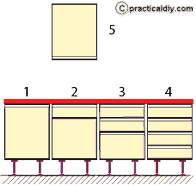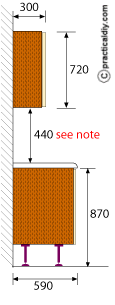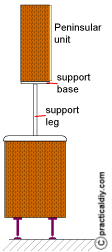Choosing Kitchen Units
basic points - base units - wall units - worktops - accessories
Irrespective of whether you are having your new kitchen designed and installed by a contractor or are doing the design and installation yourself, this article outlines the types of standard units available and gives some advice on choosing them.
Most kitchen cabinets are easy to install and are well within the capability of the average DIY person - it does get a bit more complicated if the plumbing is involved, and should a gas connection be required, that would need the services of an approved gas fitter.
Basic points to consider
There are a large number of suppliers of kitchen units for DIY installation and each one offers a range of styles, colours, method of construction and cost.
The most basic choice is probably the construction method of the basic carcass - either pre-built or self assembly (i.e. flat pack).
- Pre-built carcasses are usually more expensive (comparing units of similar materials), they require less work to install, are usually more rigid and give an assured quality of assembly.
- Self assembly carcasses are usually cheaper (again, comparing like with like), require more effort to assemble, and the quality of assembly depends upon the method used and the care taken.
The material used to make the basic carcass is usually chipboard with laminated surfaces; the prices usually reflects the quality of the chipboard and laminate - this is reflected in the thickness, density (= strength) and general quality (how well the chipboard will cope with moisture, and the laminate stand up to wear). The price of units will also often reflect the method of assembly - more expensive unit will probably use better quality fixing methods and should last longer. Pre-built carcasses are assembled in a controlled industrial environment and tend to give very strong joints. Self assembly carcasses are usually screwed together, either just into the chipboard or using a two part screw coupling.
When choosing the quality of kitchen units, you may want to consider why you are installing the kitchen:
- For your own home, you may wish to purchase high quality carcasses, this will last a long time and you can change just the doors and end panels when you update the kitchen in future.
- For a property renovation to sell, keep the kitchen in sympathy with the rest of the property - don't fit a cheap kitchen in high value property, nor an expensive kitchen in a low value property. And keep the design simple but functional.
- For a property to let, the same things as for a property renovation need to considered, but bear in mind the intended market (i.e. students or executives etc); accept that the kitchen may need updating between tenants more often than your own home.
The choice of style and colour of units are personal matters but:
- Consider the amount of natural light received by the room, if it doesn't get much light, avoid dark colours.
- Remember that the surfaces are likely to need occasional cleaning, so you may want to avoid pure light/plain colours, textured finishes etc which may discolour unevenly or be very hard to clean - a smooth surface can usually be cleaned by wiping a cloth over it.
- Don't be too outlandish with style, colour or design - you'll probably have to live with your choice for some years, and should you sell the property, an outlandish kitchen could put off a potential buyer.
- There are a number of different units widths available, but you don't have to use every one of them. Try to use one width of unit along any run with just an 'odd' size at one end or in the middle to fill the space.
- Try to keep the same style of units along a run - try not to mix High and Drawer Line styles.
- Try to keep the units on the wall the same width as the base units underneath with the drawers/doors vertical in line.
- Where wall units and the base units underneath are both cupboards, have the door hinges hung on the same side.
- From a safety point of view, do not mount wall units above or immediately to the side of hobs or cookers
Basic units options
 The basic kitchens units found in any range are:
The basic kitchens units found in any range are:
- Base units (1 to 4 - right) normally for mounting against walls and requiring a work surface or sink on top.
and
- Wall cupboards (5) usually containing a number of adjustable height shelves.
Base Units
The two basic style of base units are:
- High-Line (1 in illustration) where the front of the unit is one piece, normally a cupboard door
and - Drawer Line (2) where a drawer is at the top of the unit, with either more drawers underneath or a cupboard.
A run of units tends to look better if all the units are either high-line or drawer-line. False drawer fronts will often be fitted to give the appearance of drawer line where a sink or other appliance is positioned in the top of the unit.
Variations of the drawer line style include units with:
- 3 or 4 drawers (3 and 4 in above illustration). On 3 drawer base units, the top two drawers are often of the same height while the bottom drawer is double height. The sides of this lower drawer are often a wire frame style to provide storage for pots/pans, oven trays etc. Drawers in base units with 4 drawers are usually all the same height.
- 1 drawer with a cupboard underneath.
 The typical height of base units is 870mm while the depth (front to the back) is 570mm (which gives a total depth of 590mm when the cupboard doors or drawer fronts are taken into account). Different widths of units are available, typically 150, 300, 400, 500, 800 and 1000mm - the 800 and 1000 mm wide units being double units (usually needed to fit a sink) with two cupboard doors or drawers across the front. Usually with double units, both cupboard doors can be fitted to open the same way if required.
The typical height of base units is 870mm while the depth (front to the back) is 570mm (which gives a total depth of 590mm when the cupboard doors or drawer fronts are taken into account). Different widths of units are available, typically 150, 300, 400, 500, 800 and 1000mm - the 800 and 1000 mm wide units being double units (usually needed to fit a sink) with two cupboard doors or drawers across the front. Usually with double units, both cupboard doors can be fitted to open the same way if required.
In addition to these standard base units, most manufacturers will include in their ranges:
- Standard height corner units designed to utilise the space in a corner of the room where both adjoining walls have units fitted.
- Taller units (about 2070 or 2250mm tall). Most manufacturers will offer a choice of drawer and/or cupboard combinations.
- Appliance units to accommodate 'built-in' appliances (fridges, freezers, washing machines, dishwasher etc). These usually include doors which can be fitted to the front of the appliance so that the appearance matches with the other units.
- A range of open fronted units which can be fitted into a run or at the end of a run to finish it off.
Note:The 440 mm in the illustrations indicates the height of wall units above work surfaces, the spacing should be increased to at least 650 where wall units are mounted above hobs.
Wall units
Wall units normally include one or two shelves - on most ranges the position of the shelves are adjustable, possibly during assembly or fully adjustable.
Wall units are typically 720mm in height and 335mm in depth (increasing to 355mm when the doors are fitted). Wall units are usually available in the same widths as base units in the range - 300, 400, 500, 800 and 1000mm - and also like base units, the 800 and 1000 mm wide units have two cupboard doors - however these doors can usually only be fitted with the hinges on the sides of the unit.
In addition to standard wall units, most manufacturers will include:
- Corner units designed to continue a run of cupboards around a corner of the room.
- Tall wall units - typically 900/1080 mm in height - to provide added storage space.
- Bridging units - typically 350/360mm in height - designed to fit with the top inline with the top of adjacent wall units so increasing the height above the work surface.
- Tall units for mounting on the work surface, these give a 'Welsh Dresser' effect.
- Various glass fronted or open wall units to fit into a run of wall units or to finish off at the end.
 A 'peninsular' style unit provides storage above a work surface where there is no wall to fix the unit to. The main difference between ordinary wall units and 'peninsular' units is that the back of 'peninsular' units are better finished as it is visible after installation. Special support kits are required to mount peninsular units, these include the support legs and unit bases to take the weight of the unit and not obstruct the work surface too much.
A 'peninsular' style unit provides storage above a work surface where there is no wall to fix the unit to. The main difference between ordinary wall units and 'peninsular' units is that the back of 'peninsular' units are better finished as it is visible after installation. Special support kits are required to mount peninsular units, these include the support legs and unit bases to take the weight of the unit and not obstruct the work surface too much.
Work surfaces
The work surface needs to be chosen to fit alone the top of the base units - the choice is normally between laminated worktops and stone (granite, slate etc).
Laminated worktops are usually available in widths of 600, 850 and 900mm - they come in various lengths from 1500 to 3600 mm and can be cut to length to suit. The 4 basic styles of worktop are the three shown below, and the forth being square edged with the laminate just on the top face, strips of natural timber or other materials are then fixed to the unlaminated edges to finish them off.

Where a postformed worktop is to go around a corner, an joint strip is used to hide the postform of one piece of worktop where it runs across the other piece.
There is a wide choice of finishes for the worktop surface - there are various textured or smooth surfaces as well as different patterns to choose from. Textured surfaces can look good to begin with, but they can be a problem to keep clean in the longer term.
Accessories and extras
Finishing touches:
To finish off the external appearance of base and wall units, most manufacturers offer:
- Pelmets (for below wall units) and Cornices (for above wall units) - these create the effect that a number of wall units are just one piece of furniture. Lighting for the work surface can be fitted behind the pelmet where it will be concealed.
- Plinth panels (to fill the space between the bottom of the cupboard/drawers and the floor).
Other accessories
Most manufacturers also offer a number of extras to finish off an installation, typically these include:
- Carousel unit - to fit into a corner cupboard to make use of the storage space- these typically need to be fitted before the unit is fully assembled.
- Wire carousel - again for corner cupboards however the half-circle baskets are on a hinge attached to one side of a cupboard; when the door is open, the basket can be swung round to access stored items.
- Pull-out storage - usually fitted on runners behind the top and bottom of a high cupboard, the assembly can be pulled out to make access to stored items easy.
- Swing out storage - has a similar advantage as the Pullout storage but some of the storage space is mounted on the cupboard door - with the door open, access to the items in the back of the cupboard or on the door itself is less obstructed than it would be if all the items were on the cupboard shelves.
- Pullout storage baskets - fitted to the sides of base units behind the door.
- Narrow door storage baskets - for fitting on the inside of cupboard door - they leave most of the cupboard depth unobstructed.
- Wine storage - usually available as wall or base units or to fit inside a cupboard - can be either a simple rack or as a pullout rack.
- Spice racks - usually for fitting on the inside of a door or as small units in their own right.
- Swing waste bin - fitted to the inside of a base unit cupboard door and the side of the unit - the bin is automatically opened when the cupboard door is opened.
- Pullout waste bins - typically more than two bins, the bins are mounted inside a base unit behind a door front, when the door is opened, the bins slide out for use.
- Cutlery trays which into base unit drawers.
- Pull-out ironing board or table - these are usually fitted behind a false drawer front at the top of base units and are pulled out for use in that position.
- Towel rail - usually forming a narrow base unit, it can be fitted between 2 'normal' base units along a run.
- Tray storage area - like the towel rail it's a narrow base unit, and is usually fitted between 2 'normal' base units.
- Florescent lighting - usually fitted behind the pelmets under wall units, it illuminates the work surface.
basic points - base units - wall units - worktops - accessories
